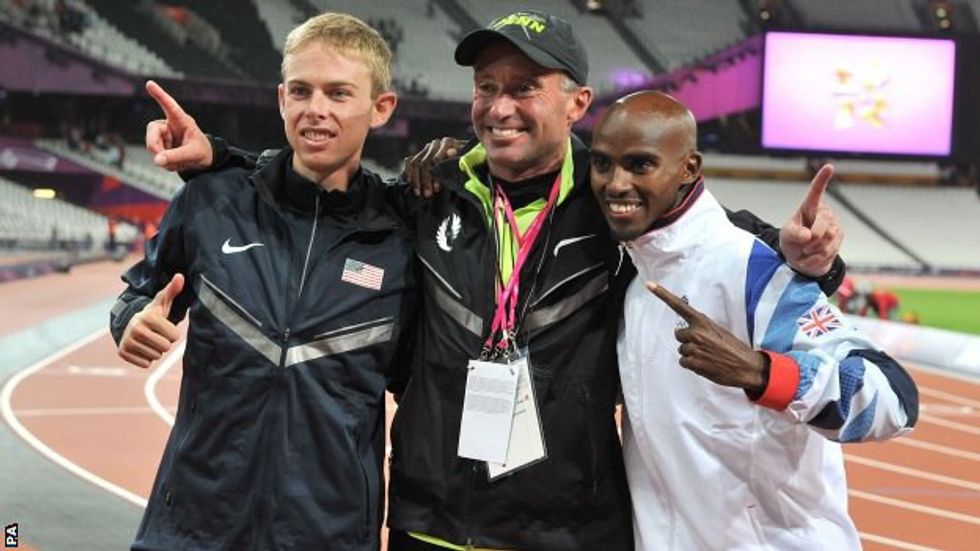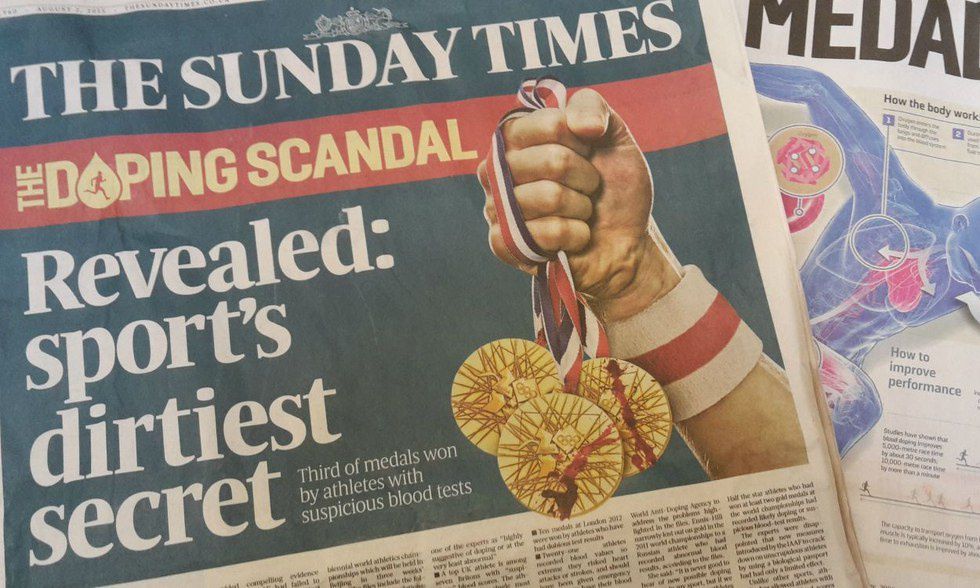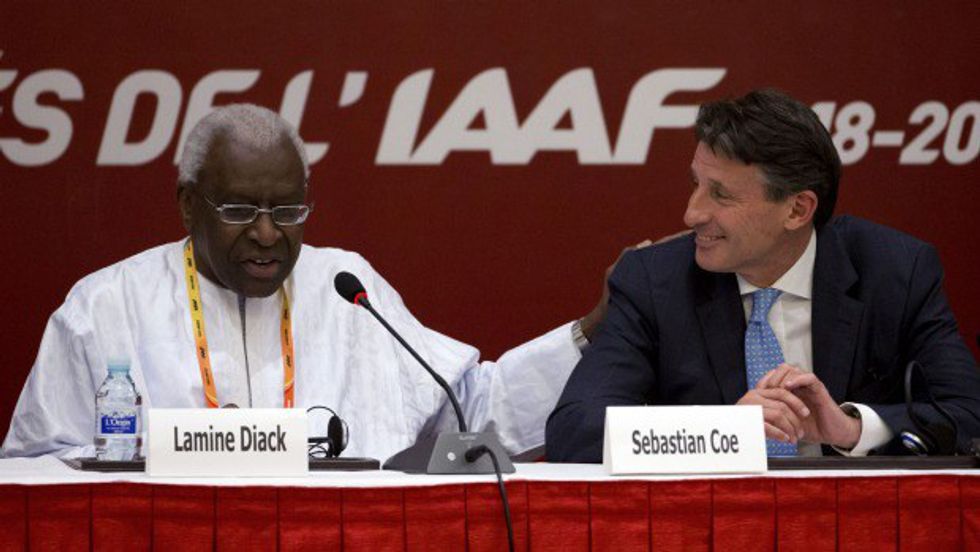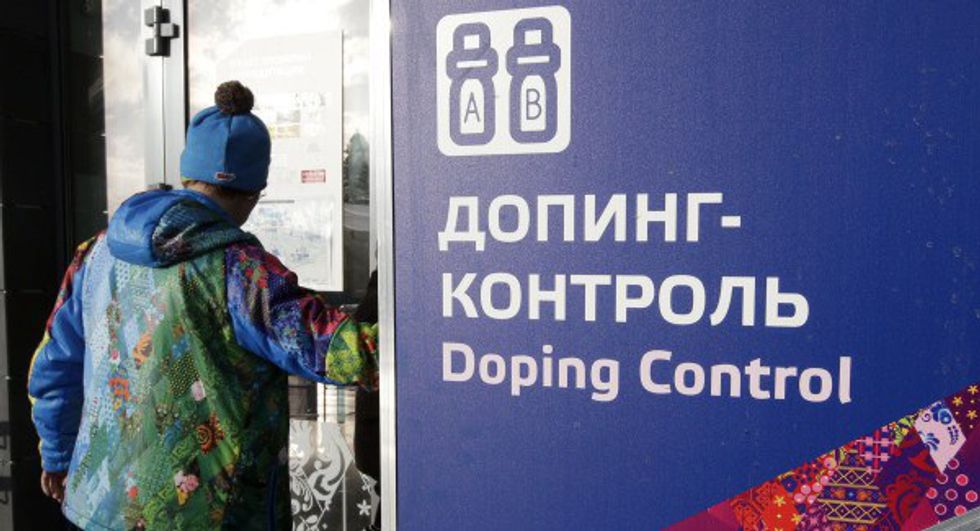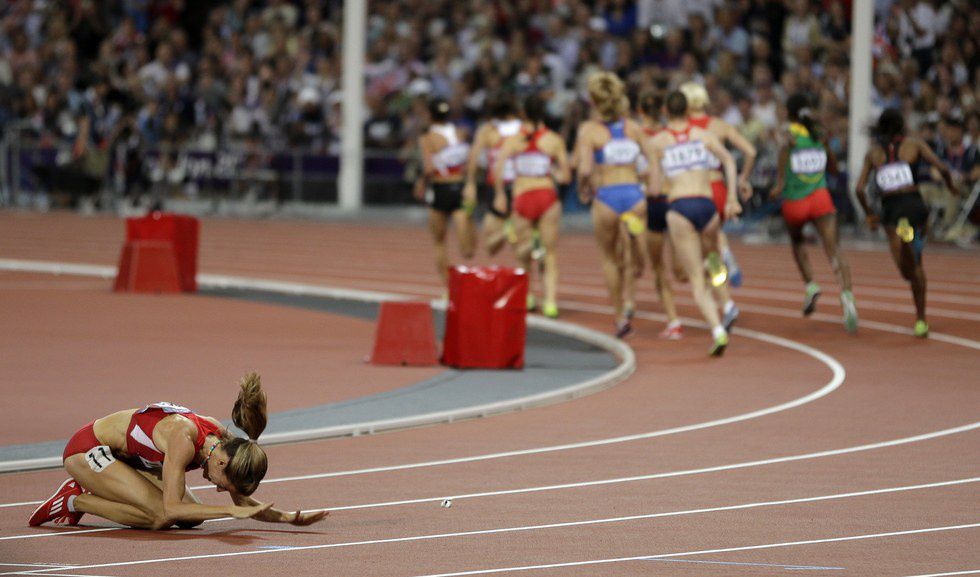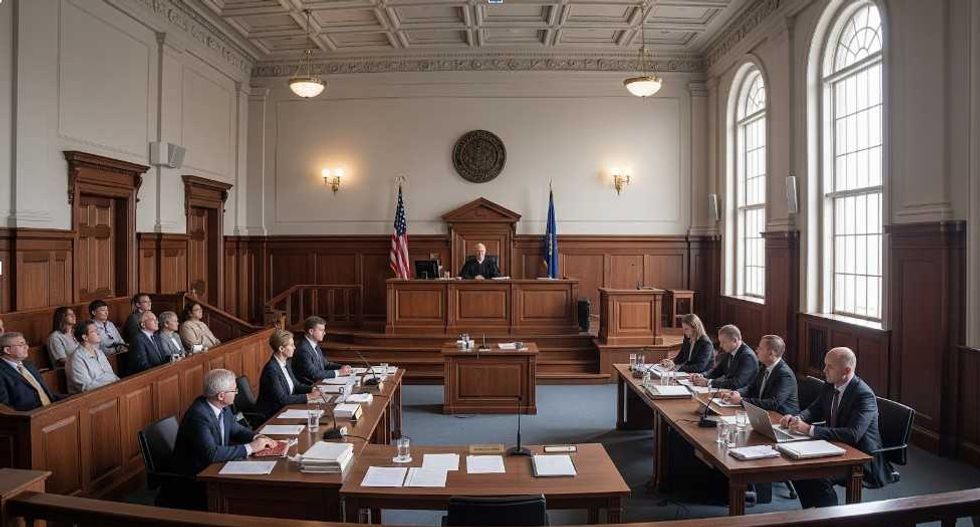"Breaking news" can come into two areas of ironic wordplay for the intricate world of track and field athletics: 1. the breaking of a national, world and/or Olympic record, or a personal best set by an athlete in his/her prospective event, or 2. the breaking of fans' hearts as they learn the men and women they look up to, who find themselves potentially placed on a pedestal- actually a podium- once every four years, are as fake as their commitment to the naturalistic philosophies they peddle.
Steroids are the glamour drug in American sports: baseball and contact sports like football or professional wrestling. Doping in track and field comes in a multitude of forms. Steroids can be used, and so can other performance enhancing drugs such as erythropoietin (EPO). Other times an athlete can even use their own blood, refrigerated and re-injected before competition. The legs and the lungs are the main components of a runner's athletic physicality; training aims to strengthen their performance thresholds and oxygen efficiency, following a path laid out by their coaches to reach a specific goal at a specific time. The flexibility of the many ways to cheat in the sport allows unfair opportunists to unethically create shortcuts.
Within the past year, two investigative journalism pieces have uncovered discrepancies in the governing bodies for worldwide athletics. German TV journalist Hajo Seppelt shed light on the fact that "as many as 99 percent of Russian athletes are guilty of doping," in his documentary "The Doping Secret: How Russia Creates Champions" from December 2014 (full video below). Allegations from the news special dug down to discover Russian event officials' history of being easily susceptible to bribes in exchange for banned substances and botched test results. As usual, dirty athletes found a way around procedures straight into competition, bypassing barriers law-abiding clean athletes have to go through, physically and bureaucratically. Seppelt's story broke the same year of the Winter Olympics held in Sochi, Russia, where the host nation finished the competition leading in most gold, silver, and overall medals earned.
Seppelt's report was supported by anecdotal evidence from various Russian athletes and officials willing to speak out to him. All-Russia Athletic Federation (ARAF) administrators denied any wrongdoings. At the time, the World Anti-Doping Agency (WADA) passed on this information to the International Association of Athletics Federation (IAAF) for further inquiry. If Seppelt's story held up to be true, the IAAF was to force its hand by penalizing the individuals or groups involved in the doping controversy, thereby enforcing bylaws sworn to to protect the sanctity of the sport by ensuring a level playing field for all competitors. That was the last we heard of Russia's alleged doping incident.
Making a full vacation out of it, I attended the Prefontaine Classic this past May 29 and 30 at the University of Oregon's track and field complex, Eugene Field. Starstruck runners got to watch their heroes, in real life, doing laps around the track as casual as just about any hobby jogger out there. Photo finishes were just that as event attendants waited for the perfect moment to get that snapshot, the one to prove you actually were there. After the races, hands holding markers with notepads, posters, even running shoes, clamored around athletes walking through the chute from the track exit to the private warm-up area. It is not everyday such conquistadors of physical limitations brush right by, even stopping for some chitchat as you try to ask the right questions and not just blurt out "great job!"
British athlete Mo Farah kicked to victory in the 10,000 meter race while American teammate Galen Rupp fell back in the standings during the 5K. And there their coach was, marathon madman Alberto Salazar, head of the Nike Oregon Project, standing in the crowd, fans too unsure to approach him. Nike spared no expense, as its innovative profit margins could indicate, in advertising to prove to everyone that they sponsored the event. After all, the meet's namesake Steve Prefontaine was one of the first runners to blaze the track with a pair of prototype Nike running spikes, made by the Oregon track coach and Nike co-founder Bill Bowerman on his waffle iron.
Hours before boarding my flight home, days after going to the internationally renowned track meet, social media lights up for once about track. On June 3, BBC’s documentary series "Panorama" aired a story headed by journalist Mark Daly titled "Catch Me If You Can" (video below). Daly placed Nike Oregon Project head coach Alberto Salazar and his star pupil Galen Rupp in the middle of another dopingscandal.
Feeling betrayed by cyclist Lance Armstrong's admittance to long-time doping in 2013, Daly researched prior athletic scandals, his analysis snowballing off of British Olympic sprinter Allan Wells'. Olympic team doctors supposedly administered steroids to multiples athletes including Wells. An avid cyclists himself, Daly went so far as to subject himself to EPO treatment to measure its effects on his training regiment, experiencing the processing of doping first hand, with all improvements carefully taken note of.
Daly's accrued evidence stayed consistent with accounts of athletes pressured to take testosterone and thyroid medications by Nike trained medical staff and Salazar himself. Former assistant coach Steve Magness even commented on Rupp's irregularly high testosterone levels on his "biological passport," created by the WADA to track an athlete's blood result history from his teen years. written off as a therapeutic use exemption (TUE) by a doctor for Rupp's asthma.
At best, Daly's report remains hearsay, lying on the legitimacy of the eyewitness testimonies. In all recollections, none of the interviews mentioned seeing any drug use going on nor any drugs, the real incriminating evidence. No one thus far have come forward confirming the administration of banned substances to athletes under Salazar's coaching. Doting on sponsor favoritism, Salazar does use his applauded veteran status to sway the influence of race judges, exploding on rival athletes suspected of tripping his runners. He may be a bully, but without any further proof, he is not a cheater.
Salazar did not make an interview appearance for Daly, but he did submit a statement to BBC, denying all allegations. Even Rupp's alleged doping as youth was caused by a therapeutic use exemption (TUE) written by his doctor for the runner's asthma, a necessary medicine explaining any spiked testosterone levels. Wells has stood adamantly by his denying of Daly's allegations against him, calling BBC's character killing statements "shocking slur[s]." Many of the athletes speaking against Wells were dopers themselves.
Albeit tarnishing an accredited coach's resume and compromising him in an investigation on his practices, Daly's broadcast does not necessarily have to be true to open people's eyes to the corruption going on behind closed doors of athletic institutions. Along with Salazar's controversy, this past summer was highlighted by the Fédération Internationale de Football Association (FIFA) coming under scrutiny for taking bribe money from countries seeking a winning bid to be the host of future World Cup tournaments. The revelation called for the FIFA president Sepp Blatter to resign, four days after being reelected.
After retiring only a few months prior, the previous IAAF president Lamine Diack was found to have been accepting payments to look the other way for doping Russian athletes to compete. Diack's son, an IAAF consultant, has been noted asking for payments in $5 million sums for Qatar's bid for hosting rights for the World Championships. The New York Times speculated if these accusations are truth, Diack was to have "demand[ed] bribes totaling more than one million euros in order to suppress positive doping tests...spend[ing] much of his mandate defending his federation’s record on anti-doping."
Diack's successor is decorated British Olympian Lord Sebastian Coe, earning golds for the 1500 meter and silvers for the 800 meter races in the 1980 and 1984 Olympics. A former athlete himself, representing his queen and country, Coe must have played an integral role in carrying the torch against the shadow of widespread corruption. A former FIFA ethics committee member, Coe should be no stranger to wide-scale fraud. Yet it grew even while he was IAAF vice president from 2007 till his succeeding Diack. BBC quotes Coe calling the IAAF's involvement in a doping scandal "just inaccurate."
England's Channel 4 newsman Jon Snow sat down with Coe, finally asking the tough questions. The engaging encounter can be summarized by Snow's question, "There are only two choices: asleep on the job or corrupt?" insinuating Coe, holding collective responsibility with the rest of the IAAF, did not see the corruption going on or was immersed in it. Coe's associations have not changed since the FIFA scandal. He sits next to the men at the helm of the bribery charges, it is relevant to add Coe considers Diack a close friend. Coe called for a review of the organization after his election, but where is the need for one if he already knows athletics is far from clean and he calls the perpetrator behind the scandal the "IAAF's 'spiritual' leader"?
In a report from former WADA president Dick Pound, Russia has been promoting a "state-sponsored doping [program]," a likely homing beacon for the nation's "deeply rooted culture of cheating." In a 323 page report, the WADA calls to attention the urgency of the situation and outlines a suspension barring Russia from international competition. Russia was recommended to act compliantly with the investigation, in order to hopefully shorten the length of the ban for innocent athletes. As of November 18, Russia and several other countries are marked as "non-compliant" for conducting doping tests in unsanctioned labs. Russia, for the moment, has been stripped of its ability to compete in the World Athletic Series meets and the Olympics games and cannot host the 2016 World Race Walking and World Junior Championships.
32 Russian athletes were banned in 2013 for doping. It is impossible to miss a constant number like that, especially if it is coming from the same program. The number grew, when an August 2015 report found 800 of 5,000 Russian athletes to have abnormalities in their blood results, indicators of doping. The WADA is pushing for several lifetime bans in the sport, including Moscow's testing director Grigory Rodchenkov for obstructing anti-doping investigations by destroying over 1,400 test samples.
American middle distance runner Alysia Montano, the most emotionally vocal athlete on the matter, may be up to receive several medals from international competition as reparation honest athletes cheated out of titles by dopers, including a possible 2012 Olympic bronze medal in the 800. Montano's pure dedication to track is exemplified by her competing last year, running a 2:32 in the 800 while eight months pregnant. Speaking out on her lost Olympic experience, Montano said, "Here’s to just hoping that justice is served. I’m just hoping that the right people get the right rewards.”Even American steeplechaser Jenny Simpson may be due for a 2009 World Championship bronze medal, who had these words to say:
"The greater evil here is the institutionalized corruption. There will always be a new wave of young, fresh athletes. There’s constantly going to be turnover, and there will always be a feeder system for that. But the people in power and the people setting up the rules and the people who create the culture of the sport, that’s a greater evil when those have manipulated their position for their own good to the detriment of the sport.”
The 2012 London Olympics were just that from the Russian athletes, "institutionalized corruption." The WADA wants lifetime bans placed on the respective gold and bronze medal winners in the 800, Mariya Savinova and Ekaterina Poistogova, the women Montano could stand to benefit from if they are banned for cheating. Marathoner Liliya Shobukhova, who just finished her temporary ban in August, had all race results from 2009 to 2014 expunged for biological passport irregularities. Even worse, Shobukhova paid $450,000 to get into the 2012 Olympic marathon, suspicion causing a 3 year, 2 month ban. The Guardian recounted a Russian athlete's understanding of the treatment of athletes: "The coaches chose a girl, fed her pills and then she’d be off. And the next day she’d be banned and then they’d say: ‘We’ll find a new one.'...If it was an unknown athlete, the test remained positive, but when it is someone famous, or someone young and a medal hopeful, then it’s a mistake, and it’s not reported.”
Few nations have athletic pandemics as serious as Russia's, besides India. For the most part, other countries suffer highly isolated incidences. Americans Tyson Gray and justin Gatlin, for example, both won the 100 and 200 meter dashes respectively at the 2015 Prefontaine Classic. Both men were caught doping, their silver Olympic 4x100 meter relay medals revoked. Almost mirroring Canadian Ben Johnson’s story from the 1988 Seoul Olympics, both sprinters were banned from track and field for several years; Johnson received a lifetime ban for failing two doping tests. Although their times in the sprinting events seem to be quietly approaching times of Usain Bolt’s caliber, one cannot say if they are getting such results out of a legitimate and clean training program. In these cases, individual athletes were suspended, not entire programs.
Russia is the target but the subject of the issue is the IAAF. They have proven unable to put a plug on ongoing doping activity and in fact catalyze it. There will always be another client willing to make a deal with the devil, paying the full price, going the full nine yards, to fake greatness. There is only one governing body to prevent that from happening, the same governing body enabling it against the prevention. Institutions of ethics should not be capitalized upon. They are not conglomerate corporations waiting for an investor. They are not supposed to bend to the will of the sponsor; the athletes already do that too often enough men like Nick Symmonds make a stand, losing out on major opportunities to succeed in exchange for sending a message.
The lack of respect shows. By the athletes doping. By the coaches giving the drugs. By the officials fixing the tests. Even by the people running the show.It is almost enough to make someone quit, detest the thing they love, question the morals they work for. The morals they run for. Runners hearts are surely broken by this. They will sit down and think about this. Then they will get over it and get up. They will devote countless hours into their art so they can show they are not this: a travesty. They will stay clean. Their test results will come out negative every time: no drugs. They will race, they will win, they will qualify, they will make it. Where? There. The place there dreams have brought them, the place they chased for so long. The Olympics. The track. The torch. The olive wreaths. Maybe, even a podium. Knowing they earned the right to all of it. From clean training and honest living.
The people running institutions of lies, greed, and deception never thing of the people willing to take it to heart. Daly may have been right about one thing: a betrayal of this magnitude gears you up to go out and prove something. Because acknowledging the falseness so many of these athletes portray in and out of the characters they play on the track may just be enough for someone to look down, away from the stars they chase, and think all the time spent dreaming was for nothing.




